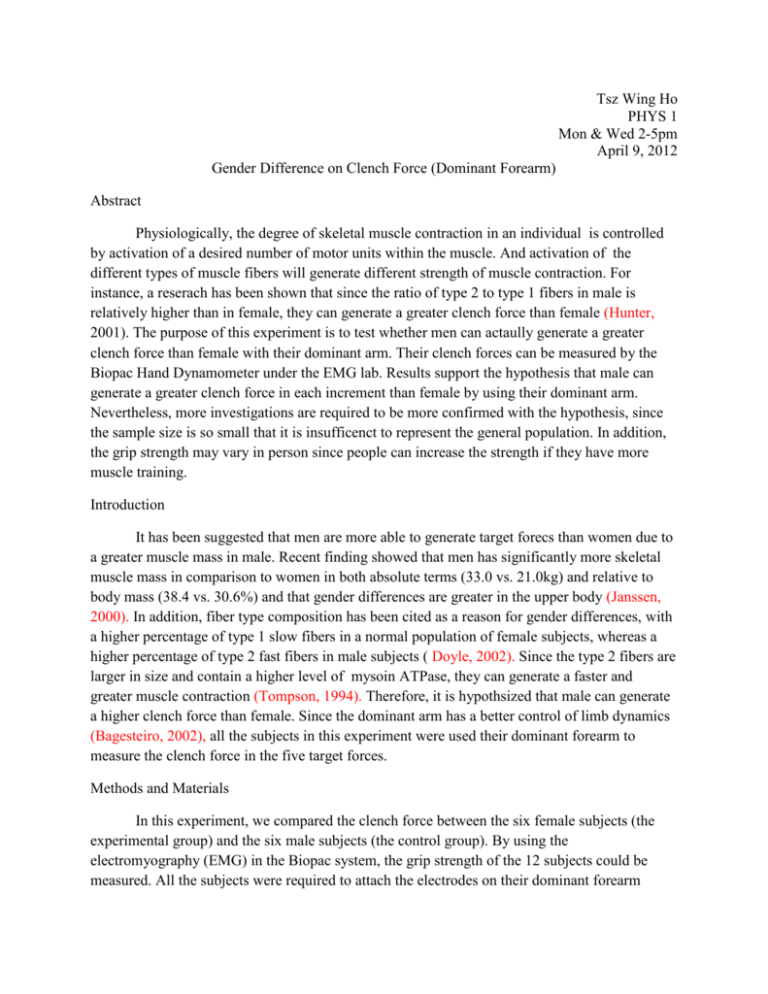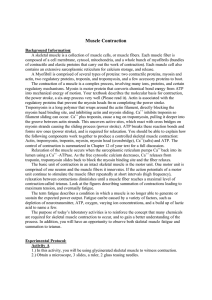muscle lab report
advertisement

Tsz Wing Ho PHYS 1 Mon & Wed 2-5pm April 9, 2012 Gender Difference on Clench Force (Dominant Forearm) Abstract Physiologically, the degree of skeletal muscle contraction in an individual is controlled by activation of a desired number of motor units within the muscle. And activation of the different types of muscle fibers will generate different strength of muscle contraction. For instance, a reserach has been shown that since the ratio of type 2 to type 1 fibers in male is relatively higher than in female, they can generate a greater clench force than female (Hunter, 2001). The purpose of this experiment is to test whether men can actaully generate a greater clench force than female with their dominant arm. Their clench forces can be measured by the Biopac Hand Dynamometer under the EMG lab. Results support the hypothesis that male can generate a greater clench force in each increment than female by using their dominant arm. Nevertheless, more investigations are required to be more confirmed with the hypothesis, since the sample size is so small that it is insufficenct to represent the general population. In addition, the grip strength may vary in person since people can increase the strength if they have more muscle training. Introduction It has been suggested that men are more able to generate target forecs than women due to a greater muscle mass in male. Recent finding showed that men has significantly more skeletal muscle mass in comparison to women in both absolute terms (33.0 vs. 21.0kg) and relative to body mass (38.4 vs. 30.6%) and that gender differences are greater in the upper body (Janssen, 2000). In addition, fiber type composition has been cited as a reason for gender differences, with a higher percentage of type 1 slow fibers in a normal population of female subjects, whereas a higher percentage of type 2 fast fibers in male subjects ( Doyle, 2002). Since the type 2 fibers are larger in size and contain a higher level of mysoin ATPase, they can generate a faster and greater muscle contraction (Tompson, 1994). Therefore, it is hypothsized that male can generate a higher clench force than female. Since the dominant arm has a better control of limb dynamics (Bagesteiro, 2002), all the subjects in this experiment were used their dominant forearm to measure the clench force in the five target forces. Methods and Materials In this experiment, we compared the clench force between the six female subjects (the experimental group) and the six male subjects (the control group). By using the electromyography (EMG) in the Biopac system, the grip strength of the 12 subjects could be measured. All the subjects were required to attach the electrodes on their dominant forearm (generally if the subject is right-handed, the electrodes will be attached on the right arm). It is suggested to using alcohol to wipe out the skin before attaching the electrodes in order to have a better connection between the electrodes and the skin. And it is better to wait for 5 minutes to give the electrodes time to establish contact with the surface of the skin. After that, the recorder could plug the electrode assembly (SS2L) into channel 3 and told the subject to seat on a chair. In order to collect a better and more accuarate result, all the subjects should be seated away from the computer screen so that they could not see their data while they were clenching on the hand dynamometer. Once the recorder logged into the Biopac Student Lab to start the experiment, He or she would have to calibrate before actually recording the subject's data. After the 8 seconds for calibration, the subjects would start to repeat a cycle of clench-release-wait. They held the clench for 2 seconds, and waited for 2 seconds after releasing before beginning the next cycle. The subject should try to increase clench strength in equal increments such that the fourth clench was the maximum clench force. We would record an incraese in the numebr of active grip muscle motor units (motor unit recruitment) as grip force increased. Result Student 1 Student 2 Student 3 Student 4 Student 5 Student 6 Mean Stdev 1 9.98 9.611 7.929 8.985 9.017 8.77 9.0487 0.709925 2 19.65 17.057 17.748 18.08 19.446 19.17 18.525 1.0475 3 28.58 22.158 29.097 28.081 28.603 38.41 29.155 5.2231 4 38.17 22.936 28.34 38.33 36.235 57.011 36.837 11.634 Table 1. The mean and the standard deviation of clench force in the 6 male subjects. Student 1 Student 2 Student 3 Student 4 Student 5 Student 6 Mean Stdev 1 4.498 5.977 3.04 8.908 3.04 5.79 5.2088 2.2147 2 8.66 9.847 6.7 19.169 2.968 9.88 9.5388 5.3842 3 13.288 14.228 11.25 23.244 4.954 14.36 13.554 5.9049 4 19.042 18.372 12.01 21.656 8.521 19.75 16.5585 5.11697 Table 2. The mean and standard deviation of clench force in the 6 female subjects. Figure 1. Dominant Forearm : The mean value of the clench force at equal increments in target forces (1: 5kg, 2: 10kg, 3: 15kg, 4: 20kg). The error bar is also shown in each target force. In Table 1 and 2. the mean and standard deviation of clench force for both male and female sunjects were calculated at each target force. And the data for both male and female subjects were used to plot a bar graph, which is shown in Figure 1. In Figure 1, the mean value of clench force for both gender was combined together at each target force. The graph shows that at each target force (5 kg, 10kg, 15kg, 20kg), the clench force of the male subjects is greater than that of the famle subjects. Discussion The result in this experiment supports the hypothesis that men are more likely to generate a greater clench force than women do. According to Figure 1, the mean value of the clench force at each target force is greater in male than in female. For instance, at the target force in 5 kg, the male subjects generate 9.05 kg clench force compared to 5.2kg clench force in the female subjects, In addition, at each tartget force, the standard deviations between male and female do not overlap each other, which indicates that the mean values of both subjects are statistically different. Hence, it further supports the hypothesis that there is actually a difference of clench force between male and female. As mentioned above, due to the fact that there is a difference in fiber type composition between male and female, men are therefore more likely to produce a greater clench force than female do. In one study comparing biceps of male and female bodybuilders, it was found that the relative amount of Type 1 fibers was comparable; however, the ratio of Type 1 to Type 2 in the male group was much higher than in the female, suggesting that there is a greater preferentail hypertrophy of Type 2 fibers in males ( Anderson, 1977). Histochemically, the type 2 fibers (also called fast fibers) have a high level of myosin ATPase, a rapid calcium release with uptake of scaroplasmic reticulum. Myosin ATPase is used to split the ATP to ADP with Pi to provide instantaneous energy for muscle contraction. Furthermore, the fast fiber is rich in glucoltic enzymes to allow instantaneous release of intramuscular glycogen. They are therefore able to activate at a rate of 2-3 times that of slow fibers. As a result, these fibers are best suited to generate a fast forceful muscle contraction (Thompson, 1994). Besides that, another study also indicated that testosterone ,one of the steriod hormones, contributes to skeletal msucle growth (Devold, 1990). Thus, men tend to have a higher muscle mass ratio to body weight than female do. Although this experiment supports the hypothesis that men can generate a greater clench force than female, further investigations are still required since only a small sample size (12 people in total) was used. It is therefore insufficent to represent the general population. Besides that, the muscle strength can be incraesed by having more training. The experimental group (female) and the control group (male) can only represent the ordinary people, so the analysis has to be excluded for those who are often tarined such as altheletes. Reference Lists 1. Anderson, P. & Henriksson, J. (1977). Capillary supply of the quadriceps femoris muscle of man: adaptive response to exercise. Journal of Physiology, 27(1), 677 - 690. 2. Bagesterio, Sainburg. (2002). Handedness: Dominant arm advantages in control of limb dynamics. AIP-JN Physiol, 88(5), 2408-2421. 3. Devold, D.L., Rotwein, P., Sadow, J.L., Novakovski, J. & Bechtel, P.J. (1990). Activation of insulin-like growth factor gene expression during work induced skeletal muscle growth. American Journal of Physiology, 259, 89 - 95. 4. Hunter S, Enoka R. Sex differences in the fatigability of arm muscles depends on absolute force during isometric contractions (2001). Journel of Apply Physiology, 91(26), 86– 94. 5. Jassen, Heymsfield, Wang, Ross (2000). Skeletal muscle mass and distribution in 468 men and women aged 18-88 yr. Journel of Apply Physiolog, 89 (1), 81-88. 6. Doyle J, Towse T (2002). Human skeletal muscle responses vary with age and gender during fatigue due to incremental isometric exercise. Journel of Apply Physiology, 93(18), 13– 23. 7. Thompson, L.V. (1994). Effects of age and training on skeletal muscle physiology and performance. Physical Therapy, 74(1), 71 - 80.










